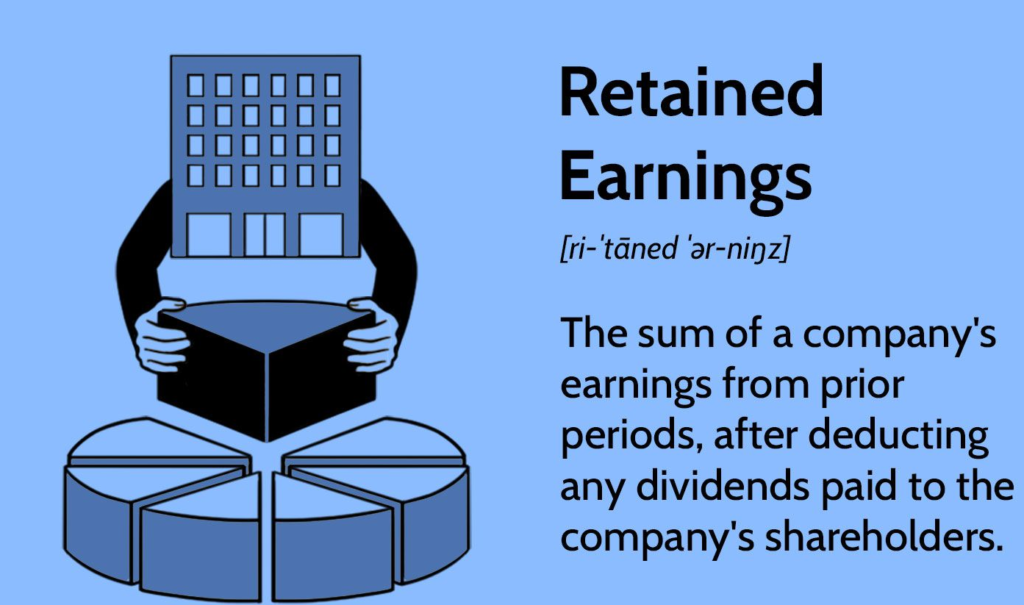Negative retained earnings
Negative retained earning is a financial condition where a company’s retained earnings, a component of shareholders’ equity on the balance sheet, show a negative balance. This typically indicates that the company has accumulated more losses than profits over time. While it might sound alarming, understanding the causes, implications, and potential remedies is crucial for comprehending a company’s financial health.
What Are Retained Earnings?
Retained earnings represent the portion of net income that is retained in the company rather than distributed as dividends. They are accumulated over time and reflect the company’s ability to reinvest profits back into its operations. Retained earnings are calculated as follows:
Ending retained earnings = Beginning retained earnings + Net income – Dividends paid
What Does Negative Retain Earnings Mean?
This situation, also known as an accumulated deficit, means that the company has experienced more losses than gains in its operational history, resulting in a negative balance.
Causes of Negative Retained Earning
- Continuous Operating Losses:
Persistent losses from operations can erode retained earnings. If a company consistently operates at a loss, its retained earnings will decline, eventually turning negative. - High Dividends:
If a company pays out dividends that exceed its profits, it can lead to negative retained earnings. This is particularly concerning if the dividends are paid despite financial losses. - Significant One-Time Expenses:
Large, non-recurring expenses such as asset write-downs, legal settlements, or restructuring costs can significantly impact retained earnings, potentially leading to a negative balance. - Impairments and Write-Offs:
Significant impairments or write-offs of assets can reduce retained earnings. These are usually recorded when there is a permanent reduction in the value of assets. - Accounting Adjustments:
Changes in accounting policies or corrections of errors from prior periods can affect retained earnings. Such adjustments can sometimes result in a negative balance if they reveal past losses.
Implications of Negative Retained Earning
- Financial Health Indicator:
Negative retained earnings can be a red flag indicating poor financial health. It suggests that the company has struggled to generate profits over time. - Impact on Shareholder Equity:
Negative retained earning reduce the overall shareholders’ equity on the balance sheet. This can affect the company’s financial stability and potentially its ability to attract investors or secure financing. - Dividend Payments:
Companies with negative retain earnings typically face limitations on dividend payments. They may be restricted from paying dividends or required to adjust their dividend policies. - Creditworthiness:
A negative retained earning balance can affect the company’s creditworthiness. Lenders and investors may view it as a risk factor, impacting the company’s ability to raise funds or secure loans. - Stock Performance:
Persistent negative retained earnings can influence stock performance. Investors may be cautious about investing in companies with a history of financial losses, which can lead to lower stock prices.
Remedies and Management Strategies
- Improving Profitability:
The most effective remedy is to focus on improving profitability through cost reduction, increasing revenues, and operational efficiencies. Generating consistent profits can help turn negative retained earnings positive. - Restructuring Operations:
Companies facing negative retain earnings may need to restructure their operations, streamline processes, and cut non-essential expenses to improve financial performance. - Debt Management:
Managing and restructuring debt can help alleviate financial pressures and improve cash flow, which is essential for returning to profitability. - Equity Financing:
Raising equity capital can help offset negative retained earning by increasing shareholders’ equity and providing funds for operational improvements. - Strategic Planning:
Implementing a robust strategic plan that includes long-term financial goals, operational improvements, and risk management can help in recovering from a negative retained earning situation.
Conclusion
Negative retain earnings reflect a company’s historical struggles with profitability, indicating that accumulate losses have exceeded accumulated profits. While it signals potential financial challenges, it also provides an opportunity for companies to reassess their strategies, improve profitability, and stabilize their financial health. By understanding the causes and implications of negative retained earnings, companies can take proactive measures to address financial issues and work towards a more positive financial future.
FAQs:
What are retain earnings?
Retain earnings are the portion of net income that is kept in the company rather than distributed as dividends.
What does negative retain earning mean?
Negative retained earnings, or an accumulated deficit, occur when a company’s cumulative losses exceed its cumulative profits.
What causes negative retain earnings?
Causes include continuous operating losses, high dividend payouts, significant one-time expenses, impairments, and accounting adjustments.
How can negative retain earning affect a company?
It can indicate poor financial health, reduce shareholders’ equity, limit dividend payments, impact creditworthiness, and affect stock performance.
Can a company with negative retained earning pay dividends?
Typically, companies with negative retained earnings may face restrictions on paying dividends or may be unable to pay them at all.
What are the financial implications of negative retain earnings?
It can impact financial stability, decrease investor confidence, and affect the company’s ability to secure financing.
How can a company improve its negative retain earnings?
By focusing on improving profitability, restructuring operations, managing debt, raising equity, and implementing strategic planning.
Is negative retain earning a common issue?
It can occur in companies with a history of operational losses or significant financial challenges, but it is not uncommon in struggling businesses.
Does negative retain earnings affect creditworthiness?
Yes, it can make a company appear riskier to lenders and investors, potentially affecting its ability to secure loans or attract investment.
Can negative retained earnings be reverse?
Yes, by generating consistent profits and improving financial performance, a company can eventually turn negative retained earnings positive
To visit https://www.gst.gov.in/
For further details access our website https://vibrantfinserv.com

